Not all walls in Jansen’s ‘Behind Walls #1’ are physical
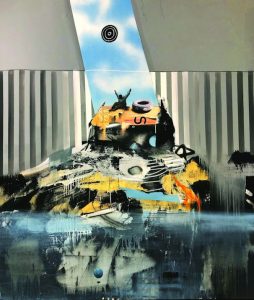 On September 25, The New York Times Style Magazine featured Marcus Jansen’s 2019 painting Behind Walls #1. The article provides interesting insight not only into the painting and the artist, but a number of current socio-political issues.
On September 25, The New York Times Style Magazine featured Marcus Jansen’s 2019 painting Behind Walls #1. The article provides interesting insight not only into the painting and the artist, but a number of current socio-political issues.
In the composition, gestural imagery suggests a fenced-off area in which the viewer is confronted with a scene depicting a cry for help from one person. “They may be initially pulled in by the colors, or what could be a light or surveillance beam shining from the sky,” Jansen remarks. “A man or woman stands on a rooftop next to a tire that could be used as a rescue 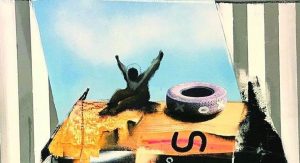 ring while a vague letter ‘S’ suggests a cry of SOS that becomes the focal point of the work.”
ring while a vague letter ‘S’ suggests a cry of SOS that becomes the focal point of the work.”
Jansen’s figures are typically universal or nondescript. Rather, he intends them to be metaphorical or at least symbolic of humanity at large and the inherent suffering of life.
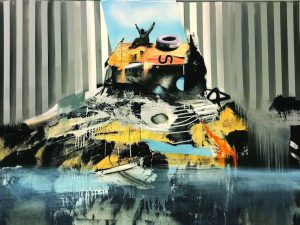 “There is a boundary in the back that isolates the incident in the foreground, and a black moon or sun that may indicate a change in time or era, or even a paradigm shift,” Marcus continues. “Most important, this painting juxtaposes fictitious elements created by my imagination, such as the wall, tire and house the person is sitting on with a human being that is affected by them. It’s a series of paradoxes that challenge the viewer to engage and compare the opposing
“There is a boundary in the back that isolates the incident in the foreground, and a black moon or sun that may indicate a change in time or era, or even a paradigm shift,” Marcus continues. “Most important, this painting juxtaposes fictitious elements created by my imagination, such as the wall, tire and house the person is sitting on with a human being that is affected by them. It’s a series of paradoxes that challenge the viewer to engage and compare the opposing  structures and their interaction with this human being. Keeping the silhouette one color allows the viewer to identify with what’s happening without insinuating any single person, group or experience.”
structures and their interaction with this human being. Keeping the silhouette one color allows the viewer to identify with what’s happening without insinuating any single person, group or experience.”
At the bottom of the composition, water contrasts with the background wall, alluding to multiple emerging threats — rising walls and rising of waters — 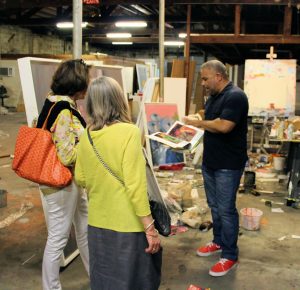 both created by our own action or inaction.
both created by our own action or inaction.
Jansen created Behind Walls #1 in the aftermath of Hurricane Maria, when Puerto Rico and Mexico were simultaneously in the news, the former contending with the flooding and wind damage caused by Maria and the latter regarding President Donald Trump’s border wall.
“I was compelled to respond to the division of humanity, whether symbolic or physical, based on belief systems. In this case, 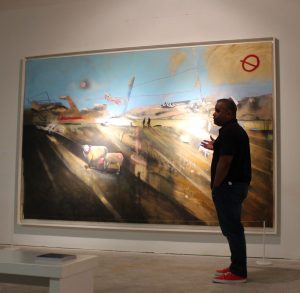 a wall that I don’t see as real, in the sense of not being able to suffer or bleed, is a manifestation of our imagination. It becomes a divider of the material world and thus part of a power structure.”
a wall that I don’t see as real, in the sense of not being able to suffer or bleed, is a manifestation of our imagination. It becomes a divider of the material world and thus part of a power structure.”
The significance of walls first entered Jansen’s consciousness and thought patterns in the 1990s. He was living at the time in Germany and responding to discoveries that the people there were making in the aftermath of the Berlin Wall, which came down in 1989. It was the same year he  joined the military.
joined the military.
“It wasn’t clear to me until I became more acquainted with people, including my late wife, who grew up behind that wall. But a more recent influence may have been the rise of walls again, as well as the isolation of colonized islands and the irony of tearing down one wall to build a new one 20 years later.”
That Jansen 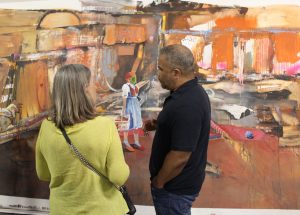 said this much about one of his paintings is unusual. His paintings establish their own dialogue with the artist as he is composing and rendering them. And as an artist, Jansen wants each viewer to establish their own dialogue with and interpretation of the painting. Toward that end, Jansen characteristically includes a multiplicity of themes, metaphors and intentionally-ambiguous
said this much about one of his paintings is unusual. His paintings establish their own dialogue with the artist as he is composing and rendering them. And as an artist, Jansen wants each viewer to establish their own dialogue with and interpretation of the painting. Toward that end, Jansen characteristically includes a multiplicity of themes, metaphors and intentionally-ambiguous  imagery. Put four (masked) people in a room with a Jansen painting, and you’re liable to hear five, ten, twenty different views on what the work is saying.
imagery. Put four (masked) people in a room with a Jansen painting, and you’re liable to hear five, ten, twenty different views on what the work is saying.
That said, it is both interesting and salient that in Behind Walls #1 Jansen juxtaposes rising walls with rising sea levels. It’s an apt summation of the problem with which the human species must grapple when it comes to the role modern technology plays in climate change.
Most climatologists and other scientists agree that the earth’s climate is warming due to human emissions of greenhouse gases.
As the global climate warms, 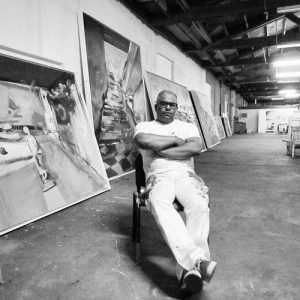 the water in the oceans increases in volume due to thermal expansion. But warming also results in land-based polar ice melting and pouring into the seas. Current estimates of sea level rise for the next century are still highly uncertain, ranging from 3-4.5 feet at the low end to as high as 6 feet by the year 2100. One recent estimate is that the seas will rise 2.3 meters (or more than 7 feet) for each degree Celsius of temperature rise (a little less than 2 degrees Farenheit).
the water in the oceans increases in volume due to thermal expansion. But warming also results in land-based polar ice melting and pouring into the seas. Current estimates of sea level rise for the next century are still highly uncertain, ranging from 3-4.5 feet at the low end to as high as 6 feet by the year 2100. One recent estimate is that the seas will rise 2.3 meters (or more than 7 feet) for each degree Celsius of temperature rise (a little less than 2 degrees Farenheit).
“Since  we expect something on the order of three to eight degrees Celsius of warming over a century, that’s 20 to 60 feet of sea level rise,” states Adam Sobel, a leading scientist in the study of extreme weather and climate.
we expect something on the order of three to eight degrees Celsius of warming over a century, that’s 20 to 60 feet of sea level rise,” states Adam Sobel, a leading scientist in the study of extreme weather and climate.
The walls in Jansen’s painting are physical, but the physical can be viewed as a manifestation of the psychological. Rather than accept the science and take prophylactic measures,  many people and politicians erect walls of denialism. Motivated by dislike of their perceived political implications, an intransigent commitment to pure free-market economic principles and the deep entrenchment of fossil fuels in nearly every aspect of our infrastructure and daily lives, they simply reject the science. “Accepting that our industrial society produces emissions
many people and politicians erect walls of denialism. Motivated by dislike of their perceived political implications, an intransigent commitment to pure free-market economic principles and the deep entrenchment of fossil fuels in nearly every aspect of our infrastructure and daily lives, they simply reject the science. “Accepting that our industrial society produces emissions 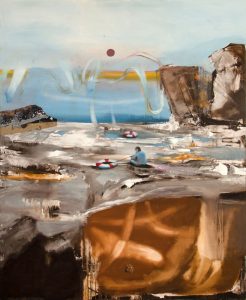 that are harming the planet seems to imply that government regulation is necessary to reduce the harm,” Sobel observes. “If you believe that all government regulation is inherently evil, you may be led to the conclusion that the harm caused by those industrial emissions must be fictional, a lie created by a conspiratorial left-wing environmentalist movement.”
that are harming the planet seems to imply that government regulation is necessary to reduce the harm,” Sobel observes. “If you believe that all government regulation is inherently evil, you may be led to the conclusion that the harm caused by those industrial emissions must be fictional, a lie created by a conspiratorial left-wing environmentalist movement.”
Either interpretation of Behind Walls #1 can and hopefully will engender thought, analysis and debate. And that, after all, is the function of artists and artworks in every epoch and culture. By that standard, Behind Walls #1 certainly furthers Jansen’s reputation for creating thoughtful and thought-evoking works of art that provide the platform for important political and social commentary.
October 7, 2020.














 Tom Hall is both an amateur artist and aspiring novelist who writes art quest thrillers. He is in the final stages of completing his debut novel titled "Art Detective," a story that fictionalizes the discovery of the fabled billion-dollar Impressionist collection of Parisian art dealer Josse Bernheim-Jeune, thought by many to have perished during World War II when the collection's hiding place, Castle de Rastignac in southern France, was destroyed by the Wehrmacht in reprisal for attacks made by members of the Resistance operating in the area. A former tax attorney, Tom holds a bachelor's degree as well as both a juris doctorate and masters of laws in taxation from the University of Florida. Tom lives in Estero, Florida with his fiancee, Connie, and their four cats.
Tom Hall is both an amateur artist and aspiring novelist who writes art quest thrillers. He is in the final stages of completing his debut novel titled "Art Detective," a story that fictionalizes the discovery of the fabled billion-dollar Impressionist collection of Parisian art dealer Josse Bernheim-Jeune, thought by many to have perished during World War II when the collection's hiding place, Castle de Rastignac in southern France, was destroyed by the Wehrmacht in reprisal for attacks made by members of the Resistance operating in the area. A former tax attorney, Tom holds a bachelor's degree as well as both a juris doctorate and masters of laws in taxation from the University of Florida. Tom lives in Estero, Florida with his fiancee, Connie, and their four cats.